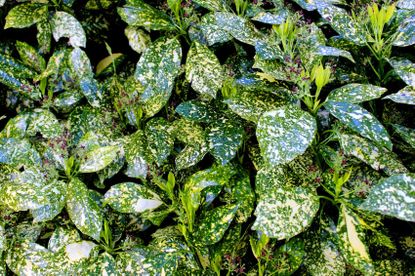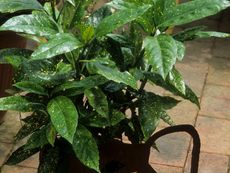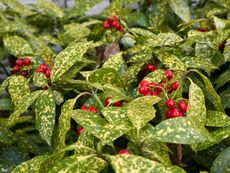Aucuba Plant Care: Learn About Aucuba Growing Conditions


Japanese aucuba (Aucuba japonica) is an evergreen shrub that grows 6 to 10 feet (2-3 m.) tall with colorful, green, and yellow gold leaves as much as 8 inches (20 cm.) long. The flowers aren't particularly ornamental, but attractive, bright red berries replace them in the fall if a male plant grows nearby. The flowers and fruit often hide behind the foliage. Aucuba also makes nice container shrubs or houseplants. Read on to learn about the care of Aucuba japonica.
How to Grow Aucuba Shrubs
Aucuba plant care is easy if you select a good location. Here is a list of ideal aucuba growing conditions:
- Shade. Deeper shade means brighter leaf color. Plants tolerate partial shade, but leaves turn black if they get too much sun.
- Mild temperatures. Japanese aucuba plants survive winters in USDA plant hardiness zones 7b through 10.
- Well-drained soil. The ideal soil is moist with a high organic content, but the plants tolerate almost any soil, including heavy clay, as long as it is well-drained.
Plant the shrubs 2 to 3 feet (61-91 cm.) apart. They grow slowly, and the area may look sparse for quite a while as they grow to fill their space. The advantage of slow growth is that the plant rarely needs pruning. Clean up plants as necessary by snipping off broken, dead, and diseased foliage and twigs. Aucuba shrubs have moderate drought tolerance, but they grow best in moist soil. Water often enough to keep the soil moderately moist using cold water. Hot water from a hose that has been left in the sun can encourage disease. Spread a 2 or 3 inch (5-8 cm.) layer of mulch over the roots to help the soil hold moisture and prevent weeds. Although they are rarely bothered by insects, you may occasionally see scales. Watch for the raised, tan spots on the leaves and stems. Scale insects leave deposits of sticky honeydew that become infested with black sooty mold. You can remove a few scale insects by scraping them off with a fingernail. Treat infestations by spraying the shrub with insecticidal soap or neem oil in early spring before the insects settle down to feed and develop their hard outer shells. Note: Aucuba is toxic if eaten. Avoid planting aucuba in areas where children play.
Gardening tips, videos, info and more delivered right to your inbox!
Sign up for the Gardening Know How newsletter today and receive a free download of our most popular eBook "How to Grow Delicious Tomatoes."

Jackie Carroll has written over 500 articles for Gardening Know How on a wide range of topics.
-
 Monkey Orchid Care: How To Grow This Fascinating Species
Monkey Orchid Care: How To Grow This Fascinating SpeciesThe monkey orchid bears a remarkable resemblance to its namesake and, with a little know-how, can be successfully grown as a houseplant.
By Bonnie L. Grant
-
 How To Grow Garden To Table: A Guide For Home Cooks
How To Grow Garden To Table: A Guide For Home CooksWhat could be better than a meal that comes directly from garden to table? Show off your gardening and culinary skills with the very freshest food.
By Bonnie L. Grant
-
 Container Grown Aucuba Shrubs: Can You Grow Japanese Laurel In A Pot
Container Grown Aucuba Shrubs: Can You Grow Japanese Laurel In A PotCan you grow Japanese laurel in a pot? Growing Japanese aucuba in containers is no problem. To learn more about container grown aucuba shrubs, the following article provides helpful information.
By Mary H. Dyer
-
 Japanese Aucuba Propagation - How To Root Aucuba Cuttings
Japanese Aucuba Propagation - How To Root Aucuba CuttingsAucuba is a lovely shrub that seems to almost glitter in the shade. Propagating aucuba cuttings is a snap. Find out how to root aucuba cuttings in this article. Click this article to get more Japanese aucuba propagation information.
By Jackie Carroll
-
 Aucuba Pruning - How And When To Prune Aucuba Shrubs
Aucuba Pruning - How And When To Prune Aucuba ShrubsOne of the most attractive home landscape plants is the Aucuba japonica. This slow-growing foliage plant assumes a shrub-like habit with glossy, pointed leaves and graceful, arching stems. Find pruning info here.
By Bonnie L. Grant